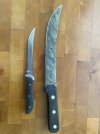Trying to start building a set of older kitchen knives and will make a knife block. I go to a lot of flea markets and see knives all the time. Not knowing much about older kitchen cutlery though, what knifes are worth keeping an eye out for? Do people collect them? Currently, just have a set of modern cuisinart knives and 6 piece set of rodgers cutlery.
-
The BladeForums.com 2024 Traditional Knife is available! Price is $250 ea (shipped within CONUS).
Order here: https://www.bladeforums.com/help/2024-traditional/
You are using an out of date browser. It may not display this or other websites correctly.
You should upgrade or use an alternative browser.
You should upgrade or use an alternative browser.
Older knives to look for
- Thread starter mjmike
- Start date
Anything marked Solingen or Sheffield (germany/england) that are in good enough shape to be restored easily. French sabatiers would be a good find too. The handles if too damaged would require replacement that may not be worth it and the blade if too pitted or too chipped (tip too) may not be worth it depending how much effort you want to put into it. Hunting on Ebay you can find them. If you want older french knives check out K Sabiter, they sell old stock from the 60s.
If you like a bit of a challenge, try to find a few knives made from Sheffield (single, double or triple) shear steel:
 www.bladeforums.com
www.bladeforums.com
 www.bladeforums.com
www.bladeforums.com
J&R Dodge Juste Judicato - double shear steel carving knife
A recent thrift shop find, and bought for a fart and three marbles (dutch expression, meaning for next to nothing) From research i learned that J&R Dodge Sheffield didn't manufacture anything themselves, but instead bought high quality cutlery, razors and tools from well established Sheffield...
 www.bladeforums.com
www.bladeforums.com
Photos - Petty's Celebrated - shear steel butcher's knife
Another thrift shop find is this old butcher's knife, made by John Petty & Sons Ltd in Sheffield. The blade is most likely shear steel, and the plan is to make the knife at least functional again. (more pics later)
 www.bladeforums.com
www.bladeforums.com
Hickory n steel
Gold Member
- Joined
- Feb 11, 2016
- Messages
- 20,724
Ontario true edge and Ontario old hickory.
Village blacksmith
Flint, and flint vanadium
Dexter , Russell, and Russell green river works
LF&C
Clyde
Lamson
Case xx
American cutlery company
Robinson
Forgecraft
Craftsman
F Dick
Wusthof
JA Henckels
Just an FYI about the Flint vanadium ( and Flint Waverly edge ) , be careful when buying from thrift stores that tape the blades because the Flint stuff I find is often bent and it's basically impossible to straighten them without snapping.
Other stuff I have succeeded with, but not the Flint.
Village blacksmith
Flint, and flint vanadium
Dexter , Russell, and Russell green river works
LF&C
Clyde
Lamson
Case xx
American cutlery company
Robinson
Forgecraft
Craftsman
F Dick
Wusthof
JA Henckels
Just an FYI about the Flint vanadium ( and Flint Waverly edge ) , be careful when buying from thrift stores that tape the blades because the Flint stuff I find is often bent and it's basically impossible to straighten them without snapping.
Other stuff I have succeeded with, but not the Flint.
nice knives. Blocks are so custom to the knives they hold, have to wait to build the block. Was out hitting up shops today for some classics, but no luck. Thinking it may take a while. Might just have to order some new old hickorys.I love your idea, OP. I stumbled across these two, the Buck is used quite frequently in the kitchen. Just a little inspiration, I suppose. Please post pics of the block you build, with the knives you find. View attachment 2094379
- Joined
- May 29, 2004
- Messages
- 3,035
Personally, I’d avoid older stainless knives as the technology wasn’t really up to snuff.
In general for a carbon steel knife, (has a patina and/or rust), these are the things I’d look for:
1) Is it attractive to me? If not, I probably won’t ever like it - I’m shallow that way.
2) Is it well designed for the job I want it to do? (Handle ergonomics/material, blade shape/thickness, balance point, finger clearance, etc.,etc.)
3) Is it perfectly straight? I’ll sight down the blade several times from several angles. This includes the edge, and any twisting or waving that occurs at the edge. If not straight, I’ll pass.
4) Is there significant rust/pitting, and does it extend under the handle? If it’s very rusty, especially under the handle scales, I’ll pass.
5) How much wear (sharpening)/damage has the edge experienced? I’ll try to think about how much work/time it’ll need when deciding if it’s worth the price.
I’d highly recommend a finish of pure Tung oil and orange oil solvent (~1:1 ratio) for old, dry wooden handled knives, as this will provide a deep, clear, waterproof, food safe surface.
I’ll include some pics of a knife I recently restored a bit for a friend. It’s a good example of a knife that I would consider “on the edge” of being too rusty to buy used, as there’s definitely some rust under the handle, and removing and replacing a handle is usually more work than I want to put into a used user…
This handle was very dry and took up lots of Tung oil - probably 15 thick coats applied 20 minutes apart before the oil finally started pooling on the surface, then I rubbed it off with a rag (let it dry or burn before disposal to avoid spontaneous combustion) and let the handle dry.
Before:
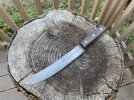
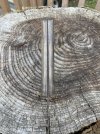
After:
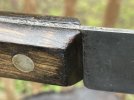
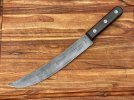
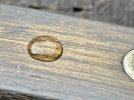
In general for a carbon steel knife, (has a patina and/or rust), these are the things I’d look for:
1) Is it attractive to me? If not, I probably won’t ever like it - I’m shallow that way.
2) Is it well designed for the job I want it to do? (Handle ergonomics/material, blade shape/thickness, balance point, finger clearance, etc.,etc.)
3) Is it perfectly straight? I’ll sight down the blade several times from several angles. This includes the edge, and any twisting or waving that occurs at the edge. If not straight, I’ll pass.
4) Is there significant rust/pitting, and does it extend under the handle? If it’s very rusty, especially under the handle scales, I’ll pass.
5) How much wear (sharpening)/damage has the edge experienced? I’ll try to think about how much work/time it’ll need when deciding if it’s worth the price.
I’d highly recommend a finish of pure Tung oil and orange oil solvent (~1:1 ratio) for old, dry wooden handled knives, as this will provide a deep, clear, waterproof, food safe surface.
I’ll include some pics of a knife I recently restored a bit for a friend. It’s a good example of a knife that I would consider “on the edge” of being too rusty to buy used, as there’s definitely some rust under the handle, and removing and replacing a handle is usually more work than I want to put into a used user…
This handle was very dry and took up lots of Tung oil - probably 15 thick coats applied 20 minutes apart before the oil finally started pooling on the surface, then I rubbed it off with a rag (let it dry or burn before disposal to avoid spontaneous combustion) and let the handle dry.
Before:


After:



Agreed, not looking for stainless. Looking for cabon.Personally, I’d avoid older stainless knives as the technology wasn’t really up to snuff.
efore:
View attachment 2096195View attachment 2096194
After:
View attachment 2096196View attachment 2096197
View attachment 2096198
- Joined
- May 29, 2004
- Messages
- 3,035
Don’t do that!!nice knives. Blocks are so custom to the knives they hold, have to wait to build the block. Was out hitting up shops today for some classics, but no luck. Thinking it may take a while. Might just have to order some new old hickorys.
Building a set of kitchen knives can be very entertaining. You’re totally on the right track going one at a time imho.
Not that I have anything against Old Hickory…
This was an actual barn find:
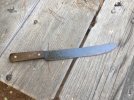
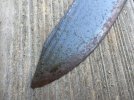
I reprofiled it and now it doubles as meat cutter and light machete. Still working on the sheath…
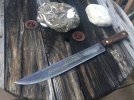
Last edited:
vltor17
Gold Member
- Joined
- Dec 5, 2008
- Messages
- 363
He’s right, you know. Maybe buy a few Old Hickorys to scratch the itch, but continue with your original plan. It’ll be worth it. I get laughed at for my “kitchen knife collection”. Screw em, it works for meDon’t do that!!
Building a set of kitchen knives can be very entertaining. You’re totally on the right track going one at a time imho.
Not that I have anything against Old Hickory…

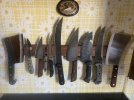
Aardvark
Gold Member
- Joined
- Nov 26, 2002
- Messages
- 5,066
You might want to remind the scoffers that it is inadvisable to laugh at someone with that many knives.He’s right, you know. Maybe buy a few Old Hickorys to scratch the itch, but continue with your original plan. It’ll be worth it. I get laughed at for my “kitchen knife collection”. Screw em, it works for me.
Which do you use most often?
vltor17
Gold Member
- Joined
- Dec 5, 2008
- Messages
- 363
The TOPS FMS and XL, tied with the stainless Buck. The right side cleaver is thin stock, works well for vegetables and such. Left side cleaver is 1/4” stock, generally use it for frozen things and bone. And the rest when I’m bored. I’m quite aware there are probably better kitchen knives out there, but I also use cast iron for most cooking tasks. Not that old, but completely stuck in my ways.You might want to remind the scoffers that it is inadvisable to laugh at someone with that many knives.
Which do you use most often?
Aardvark
Gold Member
- Joined
- Nov 26, 2002
- Messages
- 5,066
Thanks.
I've never used a big-bellied knife like the TOPS, but they sure look interesting. Really like that slicer in the middle, too.
I have an Old Hickory cleaver on which I thinned the edge, and use it for veggies. A bit thick, cut serviceable.
Love my cast iron and carbon steel pans.
I've never used a big-bellied knife like the TOPS, but they sure look interesting. Really like that slicer in the middle, too.
I have an Old Hickory cleaver on which I thinned the edge, and use it for veggies. A bit thick, cut serviceable.
Love my cast iron and carbon steel pans.
Square_peg
Gold Member
- Joined
- Feb 1, 2012
- Messages
- 13,850
We’re lucky Ontario is still making Old Hickory. If you don’t have any then pick up a few while you still can.
Square_peg
Gold Member
- Joined
- Feb 1, 2012
- Messages
- 13,850
I like old carbon steel kitchen knives. They take and hold a very sharp edge and they're easy to re-sharpen. And I like the look and feel of the old wood handles.
These are my favorite users. The top 4 are all Ontario. The bottom one is a Dexter. The 1st and 3rd see daily use. The big carver is used on holidays and also for two-handed work like splitting a head of cabbage.
The Ontarios just get straight mineral oil to protect the wood. The Dexter got 4 coats of spar varnish, essentially a bullet proof finish. The two bottom knifes are both awesome meat carvers. I mostly used the big Ontarios for carving until I got the Dexter.

These are my favorite users. The top 4 are all Ontario. The bottom one is a Dexter. The 1st and 3rd see daily use. The big carver is used on holidays and also for two-handed work like splitting a head of cabbage.
The Ontarios just get straight mineral oil to protect the wood. The Dexter got 4 coats of spar varnish, essentially a bullet proof finish. The two bottom knifes are both awesome meat carvers. I mostly used the big Ontarios for carving until I got the Dexter.

- Joined
- Jun 14, 2020
- Messages
- 146
From the USA, I'd add R.H. Forschner (mostly supplied OEM by Victorinox--but not 100%) and Chicago Cutlery. Both could yield "finds."Trying to start building a set of older kitchen knives and will make a knife block. I go to a lot of flea markets and see knives all the time. Not knowing much about older kitchen cutlery though, what knifes are worth keeping an eye out for? Do people collect them? Currently, just have a set of modern cuisinart knives and 6 piece set of rodgers cutlery.
I like old carbon steel kitchen knives. They take and hold a very sharp edge and they're easy to re-sharpen. And I like the look and feel of the old wood handles.
These are my favorite users. The top 4 are all Ontario. The bottom one is a Dexter. The 1st and 3rd see daily use. The big carver is used on holidays and also for two-handed work like splitting a head of cabbage.
The Ontarios just get straight mineral oil to protect the wood. The Dexter got 4 coats of spar varnish, essentially a bullet proof finish. The two bottom knifes are both awesome meat carvers. I mostly used the big Ontarios for carving until I got the Dexter.

Last edited:

